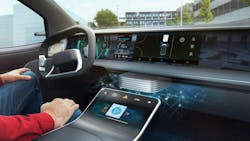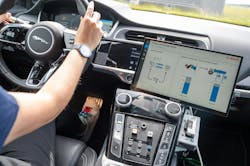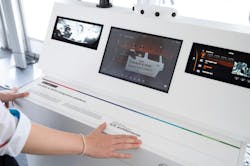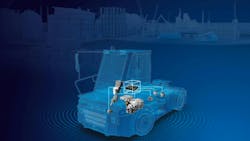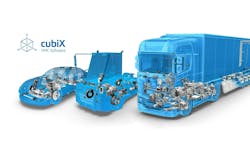Software-Defined Vehicles Driving Future Growth Opportunities
Software has become an increasingly important part of vehicles and mobile machines, as well as the systems which enable them to function. This has led to the prominence of what has been termed software-defined vehicles — those in which the user experience is affected in some manner by software such as over-the-air updates.
The software-defined vehicle (SDV) market will continue to grow in the coming years as software increasingly becomes the starting point for the development of new vehicle models, noted technology company Bosch during its Tech Day 2024. It cites a McKinsey study which estimates the global market for automotive software and electronics will reach 462 billion dollars by 2030 and from 2023 on the share of software in vehicles will triple.
Research firm IDTechEx is also projecting growth for this market with it currently forecasting it to be worth more than $700 billion by 2034 and these vehicles representing about 20% of the global car market. According to IDTechEx, the SDV market will achieve a 34% CAGR (compound annual growth rate) between 2023 and 2034 due to continued improvements in onboard hardware capabilities, in-car connectivity, and a global shift in consumer preferences toward subscription models.
Greater inclusion of advanced driver assistance systems (ADAS), such as emergency braking, and the move toward higher levels of autonomy will aid further growth of the SDV market as well because of the reliance on software for these systems.
As this market grows, so too will the technological developments and opportunities for manufacturers of all types, including those in the fluid power and electric motion control space which serve various vehicle sectors.
READ MORE - The Beneficial Effects of Thermal Cameras on Emergency Braking Systems
Software Enables Performance Enhancements
Bosch sees the SDV market as a growth opportunity because of its ability to provide both the hardware and software required in these vehicles.
During its Tech Day 2024, the company introduced several products demonstrating these capabilities, such as its eBrake to Zero function which utilizes software to create smoother braking in electric vehicles. By optimally controlling a vehicle’s electric motor and braking system, the motor is able to bring a vehicle to a stop without using the hydraulic brake explained Bosch in its press release announcing the availability of the technology.
This prevents the jolt which often occurs after a vehicle comes to a stop as well as reduces the amount of noise associated with braking. And if the hydraulic brake is required, the software ensures the transition from motor brake to hydraulic brake goes unnoticed by the vehicle occupants said Bosch.
“We can ensure jolt-free stop-and-go driving with software that brakes as smoothly as a professional chauffeur,” said Dr. Markus Heyn, member of the board of management of Bosch and chairman of the Mobility business sector.
Enabling smoother, quieter braking not only improves comfort for those within a vehicle but can also help to reduce the amount of wear and tear that might otherwise occur on components.
Inclusion of more software-based systems like this will also help to make vehicles “updateable” said Heyn. The ability to update software over the air — usually via a Wi-Fi connection and a feature that has been available in the trucking sector for some time now — will allow new functions to more easily be added to vehicles, extending their longevity.
SDV will Require New System Architectures
As vehicles become more software-defined, their architecture will change. Matt Via, Vice President of Sales and Marketing at HED Inc., discussed the need for new system architectures for SDV due to the data processing that will be required during the National Fluid Power Association’s (NFPA) December 2023 quarterly technology conference.
He explained that currently vehicle controls are organized around functions with wired inputs and outputs, referred to as a domain architecture. This typically necessitates use of at four CANbuses to move data.
However, SVD will require higher levels of data processing and so it may be likely that vehicle manufacturers move to a zonal architecture in which functions are moved to different locations on a vehicle.
Bosch agrees there will be a shift away from a domain-specific IT and electronics architecture to one that is centralized and cross-domain with just a few computers and sensors that are powerful enough to handle the required computing.
The company said vehicles today contain about 100 control units from different manufacturers, but future SDV will use less than one dozen vehicle computers for all control functions. To do, functions will be combined in more modern vehicle computers.
At its Tech Day, Bosch introduced a new vehicle computer to meet this need which was developed in collaboration with Qualcomm. It combines infotainment and driver assistance functions, enabling vehicle manufacturers to reduce installation space, cabling and weight. This also makes it easier to integrate automated driving functions into compact- and middle-class vehicles which are more space constrained.
In addition, combining multiple functions into a single unit also lowers costs as only one unit needs to be purchased and installed instead of multiple units.
New Technologies Ease Development of Software-Defined Vehicles
ZF recently announced its cubiX advanced motion control system will now be available for commercial vehicles as well as passenger cars. This central control unit was developed to meet the needs of the growing SDV market which is utilizing more electronic control functionalities.
cubiX uses software control for all actuators — including braking, steering and driveline — to ensure safe, stable and precise performance in all driving conditions. It can be customized to specific customer needs and includes software, hardware as well as system integration and system engineering services.
With cubiX, vehicle operators can easily adjust driving characteristics to meet the requirements at hand. As an example, ZF said the version used in the passenger car market has a “Trailer Stability Assist” function to minimize the inclination of trailers to ensure no safety issues occur related to the stability of the entire car-trailer combination. The company explained the assistance function available in cubiX corrects this in a targeted, concise and prompt way to increase stability and safety without the vehicle having to reduce its cruising speed.
As cubiX interfaces with all virtual driver systems and vehicle actuators — and includes all necessary components — the development process is eased for commercial and passenger vehicle manufacturers as well as their system suppliers. Instead of spending time and money on developing this type of technology themselves, they can focus on their core competencies and know the vehicle’s motion control systems will work as desired.
READ MORE - Sensors and Software in Motion Control: Key Benefits to Consider
Semiconductor supplier Renesas Electronics Corp. is also working to ease the development of SDV with its recently launched R-Car Open Access (RoX). It is a development platform which integrates all essential hardware, operating systems, software and tools for those in the automotive market developing SDV.
With all fundamental layers for the development of SDV integrated into RoX, design complexities are reduced for OEMs and their suppliers which also helps to reduce design time and cost. In addition, the Renesas solution provides a cloud-native development environment and simulation platform which enables engineers to build their software even if the accompanying hardware is not available. Renesas said users can design, debug in simulation, and verify their software before deploying it on live SoCs (system on chips) and MCUs (microcontrollers).
“Today, car OEMs and Tier 1 suppliers are heavily investing in software development and maintenance. Renesas understands this challenge and is closely working with them to deliver a flexible, ready-to-deploy development solution that can be maintained throughout the vehicle’s lifespan,” said Vivek Bhan, Senior Vice President and General Manager of High Performance Computing at Renesas.
Software-defined vehicles are the future as automation and electrification advances and cars, trucks and other modes of transport become more connected. This will require a shift in some of the technologies utilized, as well as opportunities for new solutions.
About the Author
Sara Jensen
Executive Editor, Power & Motion
Sara Jensen is executive editor of Power & Motion, directing expanded coverage into the modern fluid power space, as well as mechatronic and smart technologies. She has over 15 years of publishing experience. Prior to Power & Motion she spent 11 years with a trade publication for engineers of heavy-duty equipment, the last 3 of which were as the editor and brand lead. Over the course of her time in the B2B industry, Sara has gained an extensive knowledge of various heavy-duty equipment industries — including construction, agriculture, mining and on-road trucks —along with the systems and market trends which impact them such as fluid power and electronic motion control technologies.
You can follow Sara and Power & Motion via the following social media handles:
X (formerly Twitter): @TechnlgyEditor and @PowerMotionTech
LinkedIn: @SaraJensen and @Power&Motion
Facebook: @PowerMotionTech

Leaders relevant to this article:
